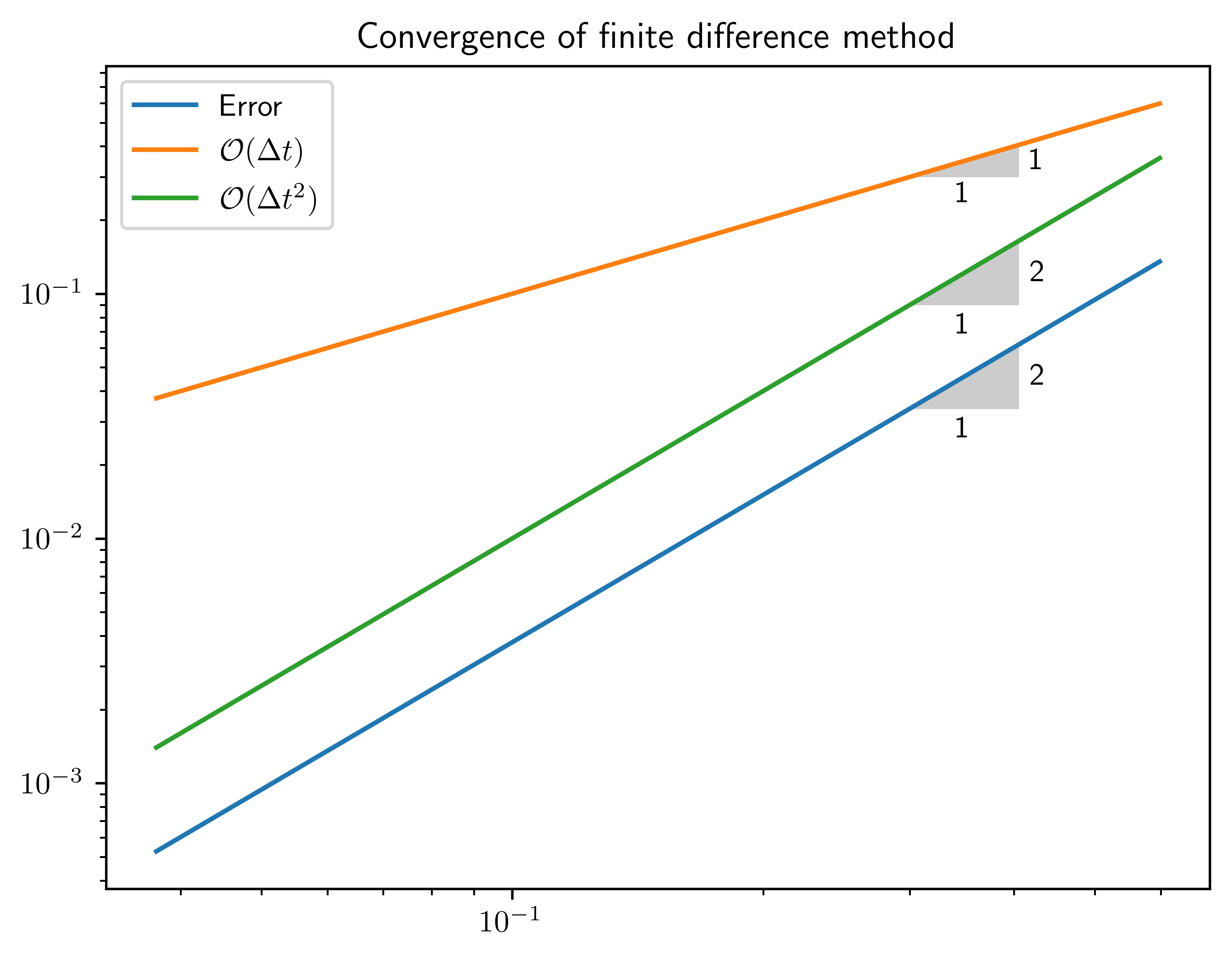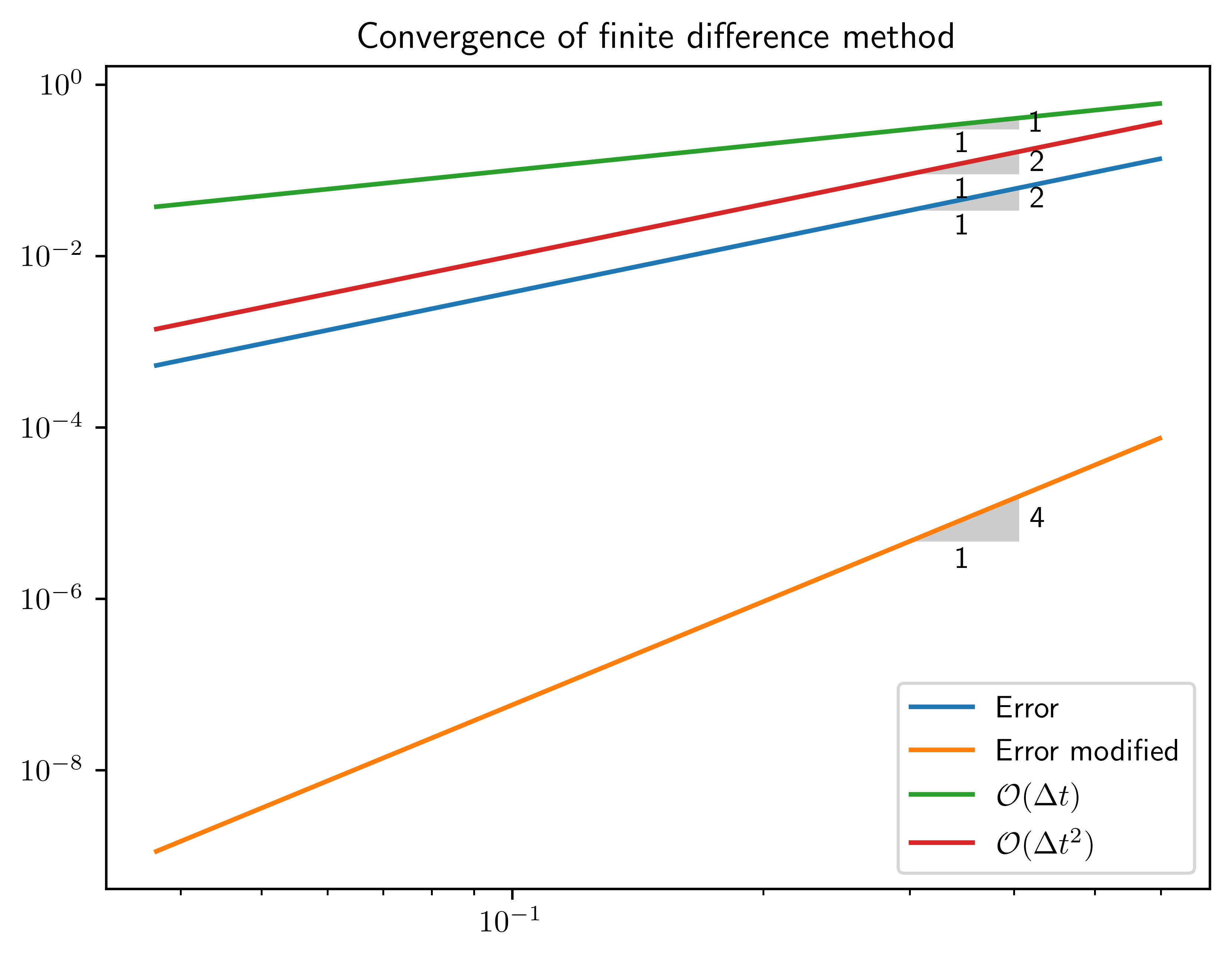87. Lecture 3#
87.1. Vibration equation#
The vibration equation can be written as
where \(\omega\) and \(I\) are given constants. This equation is often also referred to as the Helmholtz equation. A simple, recursive, finite difference method for solving the vibration equation is
where \(u^n = u(t_n)\) and \(t_n = n \Delta t\).
A recursive solver can easily be created using Numpy:
import matplotlib.pyplot as plt
import numpy as np
from plotslopes import slope_marker
def solver(dt, T, w=0.35, I=1):
"""
Solve Eq. (1)
Parameters
----------
dt : float
Time step
T : float
End time
I, w : float, optional
Model parameters
Returns
-------
t : array_like
Discrete times (0, dt, 2*dt, ..., T)
u : array_like
The solution at discrete times t
"""
dt = float(dt)
Nt = int(round(T / dt))
u = np.zeros(Nt + 1)
t = np.linspace(0, Nt * dt, Nt + 1)
u[0] = I
u[1] = u[0] - 0.5 * dt**2 * w**2 * u[0]
for n in range(1, Nt):
u[n + 1] = 2 * u[n] - u[n - 1] - dt**2 * w**2 * u[n]
return t, u
def u_exact(t, w=0.35, I=1):
"""Exact solution of Eq. (1)
Parameters
----------
t : array_like
Array of times to compute the solution
I, w : float, optional
Model parameters
Returns
-------
ue : array_like
The solution at times t
"""
return I * np.cos(w * t)
We now want to compute convergence rates. We will use the \(\ell^2\)-norm computed as
for a given uniform mesh level \(i\). For example, we can use \(N^0_t=8, N_t^{1}=16, N^2_t = 32\), etc., such that \(\Delta t_{1} / \Delta t_2 = 2\) and \(\Delta t_{n-1} / \Delta t_{n} = 2\) for all \(n\). Note that there are \(N_t^{i}\) intervals on level \(i\) and \(N_t^{i}+1\) points.
We assume that the error on the mesh with level \(i\) can be written as
where \(C\) is a constant. This way, if we have the error on two levels, then we can compute
and isolate \(r\) by computing
So by computing the error on two different levels we can find the order of the convergence!
Let’s first write a function that computes the \(\ell^2\) error of the solver defined above
def l2_error(dt, T, w=0.35, I=0.3, sol=solver):
"""Compute the l2 error norm of result from `solver`
Parameters
----------
dt : float
Time step
T : float
End time
I, w : float, optional
Model parameters
sol : callable
The function that solves Eq. (1)
Returns
-------
float
The l2 error norm
"""
t, u = sol(dt, T, w, I)
ue = u_exact(t, w, I)
return np.sqrt(dt * np.sum((ue - u) ** 2))
and then compute the convergence rates
def convergence_rates(m, dt0=30, num_periods=8, w=0.35, I=0.3, sol=solver):
"""
Return m-1 empirical estimates of the convergence rate
based on m simulations, where the time step is halved
for each simulation.
Parameters
----------
m : int
The number of mesh levels
dt0 : int, optional
Time steps per period on coarsest level
num_periods : int, optional
Size of domain is num_periods * 2pi / w
w, I : float, optional
Model parameters
sol : callable
The function that solves Eq. (1)
Returns
-------
array_like
The m-1 convergence rates
array_like
The m errors of the m meshes
array_like
The m time steps of the m meshes
"""
P = 2 * np.pi / w
dt = P / dt0
T = P * num_periods
dt_values, E_values = [], []
for i in range(m):
E = l2_error(dt, T, w, I, sol=sol)
dt_values.append(dt)
E_values.append(E)
dt = dt / 2
# Compute m-1 orders that should all be the same
r = [
np.log(E_values[i - 1] / E_values[i]) / np.log(dt_values[i - 1] / dt_values[i])
for i in range(1, m, 1)
]
return r, E_values, dt_values
Test it
convergence_rates(4)
([np.float64(2.0036366687367093),
np.float64(2.0009497328195964),
np.float64(2.000240106059535)],
[np.float64(0.13526035155205304),
np.float64(0.03372995596052594),
np.float64(0.008426939670390834),
np.float64(0.0021063843253281145)],
[0.5983986006837702,
0.2991993003418851,
0.14959965017094254,
0.07479982508547127])
These last two lists are the errors and timesteps af all the \(m\) levels. We can plot the error as a function of timestep and show that the discretization scheme is second order.
r, E, dt = convergence_rates(5)
plt.loglog(dt, E)
plt.loglog(dt, dt)
plt.loglog(dt, np.array(dt) ** 2)
plt.title("Convergence of finite difference method")
plt.legend(["Error", r"$\mathcal{O}(\Delta t)$", r"$\mathcal{O}(\Delta t^2)$"])
slope_marker((dt[1], E[1]), (2, 1))
slope_marker((dt[1], dt[1]), (1, 1))
slope_marker((dt[1], dt[1] ** 2), (2, 1))
We see that the error has the same slope as \(\Delta t^2\).
We can write a test for the order of accuracy:
def test_order(m):
r, E, dt = convergence_rates(m)
assert np.allclose(np.array(r), 2, atol=1e-2)
test_order(5)
87.2. Method of manufactured solution#
We will now use the method of manufactured solutions (MMS) to verify that the solver works. This is a method that will be used a lot throughout the course.
With the MMS we first need to assume that we know the solution. For example, we assume that the solution is
It is important that the solution satisfies the boundary conditions: \(u(0)=0\) and \(u'(0)=0\). However, if we plug the solution into the Helmholtz equation, we do not get a zero right hand side
So we need to use a nonzero right hand side of Eq. (87.1). Since in this case \(u=t^2\) we get
We also know that a second order accurate finite difference solution should be exact for a second order polynomial. Check:
dt = 0.1
T = 10
Nt = int(round(T / dt))
t = np.linspace(0, Nt * dt, Nt + 1)
u = t**2
uc = (u[2:] - 2 * u[1:-1] + u[:-2]) / dt**2
assert np.allclose(uc, 2)
The numerical solution is exact!
Assume now that the solution is
Initial conditions still ok. Now the equation becomes
Since the solution is a fourth order polynomial, the second order numerical solution will not be exact, but it will converge
dt = 0.1
Nt = int(round(T / dt))
t = np.linspace(0, Nt * dt, Nt + 1)
u = t**4
uc = (u[2:] - 2 * u[1:-1] + u[:-2]) / dt**2
print(uc - 12 * t[1:-1] ** 2)
[0.02 0.02 0.02 0.02 0.02 0.02 0.02 0.02 0.02 0.02 0.02 0.02 0.02 0.02
0.02 0.02 0.02 0.02 0.02 0.02 0.02 0.02 0.02 0.02 0.02 0.02 0.02 0.02
0.02 0.02 0.02 0.02 0.02 0.02 0.02 0.02 0.02 0.02 0.02 0.02 0.02 0.02
0.02 0.02 0.02 0.02 0.02 0.02 0.02 0.02 0.02 0.02 0.02 0.02 0.02 0.02
0.02 0.02 0.02 0.02 0.02 0.02 0.02 0.02 0.02 0.02 0.02 0.02 0.02 0.02
0.02 0.02 0.02 0.02 0.02 0.02 0.02 0.02 0.02 0.02 0.02 0.02 0.02 0.02
0.02 0.02 0.02 0.02 0.02 0.02 0.02 0.02 0.02 0.02 0.02 0.02 0.02 0.02
0.02]
Let’s take a closer look at the numerical accuracy. The finite differece expression for \(u''\) comes from two Taylor expansions around \(t_n\)
Adding now (87.2) and (87.3) and we get
such that
There is a second order error proportional to \(u''''\). For \(u=t^2\) we have that \(u''''=0\), and as such no numerical error for our scheme. For \(u=t^4\) the numerical error is \(2 \Delta t^2\)
We can put the numerical expression into our equation and get
The residual is \(\Delta t^2 u'''' / 12\).
Go back and check that the solution for \(u=t^4\) correspond exactly to this residual:
assert np.allclose(uc - 12 * t[1:-1] ** 2, 2 * dt**2)
It is exact because the next error term will be proportional to the sixth derivative of \(u\), which is zero for \(u=t^4\).
87.3. Adjusted solver#
def adj_solver(dt, T, w=0.35, I=1):
"""
Solve Eq. (1)
Parameters
----------
dt : float
Time step
T : float
End time
I, w : float, optional
Model parameters
Returns
-------
t : array_like
Discrete times (0, dt, 2*dt, ..., T)
u : array_like
The solution at discrete times t
"""
dt = float(dt)
Nt = int(round(T / dt))
u = np.zeros(Nt + 1)
t = np.linspace(0, Nt * dt, Nt + 1)
u[0] = I
u[1] = u[0] - 0.5 * dt**2 * (w * (1 - w**2 * dt**2 / 24)) ** 2 * u[0]
for n in range(1, Nt):
u[n + 1] = (
2 * u[n] - u[n - 1] - dt**2 * (w * (1 - w**2 * dt**2 / 24)) ** 2 * u[n]
)
return t, u
r, E, dt = convergence_rates(5, sol=solver)
r2, E2, dt2 = convergence_rates(5, sol=adj_solver)
plt.loglog(dt, E)
plt.loglog(dt2, E2)
plt.loglog(dt, dt)
plt.loglog(dt, np.array(dt) ** 2)
plt.title("Convergence of finite difference method")
plt.legend(
[
"Error",
"Error modified",
r"$\mathcal{O}(\Delta t)$",
r"$\mathcal{O}(\Delta t^2)$",
]
)
slope_marker((dt[1], E[1]), (2, 1))
slope_marker((dt2[1], E2[1]), (4, 1))
slope_marker((dt[1], dt[1]), (1, 1))
slope_marker((dt[1], dt[1] ** 2), (2, 1))


